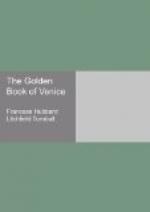Their homes—long, low, white-washed cottages—spread along the main channel and reach in lessening, dotted lines far off into the sea, where other islands lie in friendly nearness; but the Bridge, with the Lions of St. Mark on archivolt and parapet—the invariable official signet of Venetian dominion—stretches between that simpler quarter and this, which holds the great houses of Murano, whose masters, a sort of petite noblesse, have made their names illustrious by marvelous inventions in that exquisite industry in which Venice has no rival.
VI
The “Madonna del Sorriso” now lacked only the finishing touches upon the exquisite central figure, which reached more nearly to the spiritual ideal than anything that had ever come from the brush of the Veronese, and already the Servite friars, in their long black robes and white cowls, had visited the studio with suggestions many and fruitless, serving only to arouse the artist’s indignant protest and increase his determination to image more perfectly the poetic vision that had been vouchsafed to him.
“It hath not the beauty of the ‘Venezia’ in the palazzo,” said one.
“And the church is dark,” said another, “and the people like the red and blue of the colors of the true Madonna.”
“And a frate, of the Servi—since it hath been painted for the convent—here—kneeling,” suggested another, more timidly; for it was known that the Veronese was not always docile in these days, since he had become great.
“Nay, leave me,” said the Veronese fiercely; “for this one thing I know, and this will I paint, for the good of my soul, as mine art shall prompt me and not otherwise. And if it please not him—Fra Paolo, who hath given the order—I will bestow it elsewhere.”
Then a friar habited like the others, who had stood apart and had not spoken, came and threw back his cowl, dismissing the group with a gesture. The features thus disclosed were unimportant, apart from the domelike forehead, which might well belong to the most learned man of his learned age; but Fra Paolo’s face owed its distinction to the rare impression it gave the beholder of invincible calm and self-mastery, with a certain mysterious hint of power and a promise of unswervingness. His gaze held no suggestion of concealment; yet for the deeper thoughts that move the spirit of man, to those who knew him well his mild blue eyes remained inscrutable, while his courtesy to all made one forget that his words were few, and that of himself he had revealed nothing.
“It is well,” he said, “to know that we know. Serve faithfully the God who gave the gift and take no counsel from men who know not.”
Then he stood silent for a while before the picture, as if he would learn its meaning, the artist watching anxiously, not guessing his thought.
“The pious wish hath made the offering noble,” he said at length, in quiet, measured tones. “And for the face, it is holy—of the beauty that God permits—yet I pretend no criticism, since Art is not of mine understanding. I will not take the honor of the gift away from the giver, though I had meant it otherwise.”




